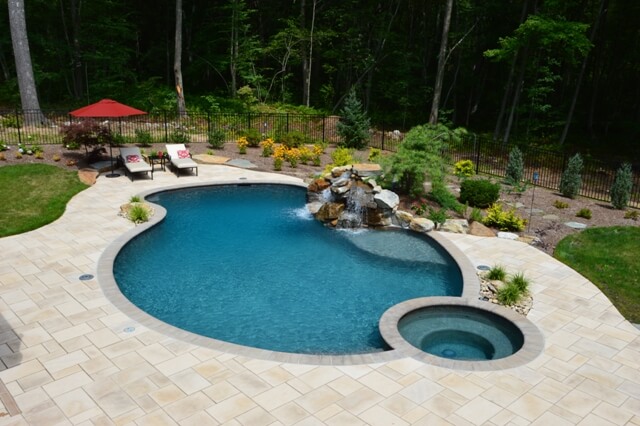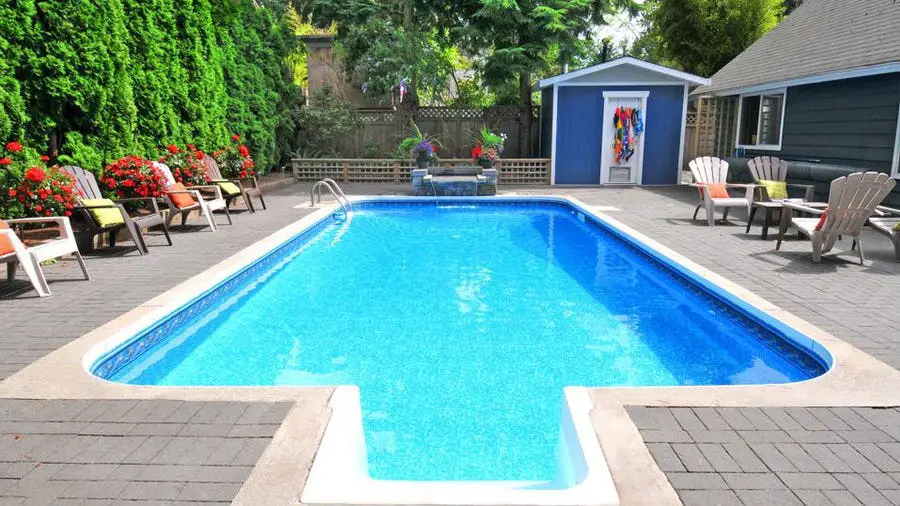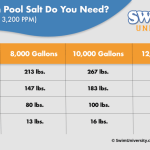An inground pool typically costs around $35,000 to $60,000. An inground pool is a significant investment that adds value and enjoyment to your property.
It offers a private retreat for relaxation, exercise, and entertainment right in your backyard. Whether you envision a sleek and modern pool or a luxurious oasis, the cost will largely depend on factors such as the size, shape, depth, and material of the pool, as well as additional features like lighting, heating, and landscaping.
It is important to consider ongoing maintenance and operational costs when budgeting for an inground pool, including pool chemicals, water treatment, and energy consumption. By weighing all these factors, you can make an informed decision on installing an inground pool that fits your budget and lifestyle.

Credit: www.shorelinepoolsinc.com
Factors Impacting Cost
When it comes to the cost of an inground pool, several factors play a crucial role in determining the overall expenditure. Understanding these influences can help homeowners make informed decisions when planning to install a pool. Below, we’ll explore the main factors that impact the cost.
Size Of The Pool
The size of the pool is a significant determinant of the overall cost. Generally, larger pools require more materials, excavation, and labor, leading to a higher total cost. In contrast, smaller pools will incur lower expenses due to reduced requirements for materials and labor.
Materials Used
The materials used in constructing an inground pool can have a substantial impact on the total cost. The choice of materials, such as concrete, fiberglass, or vinyl, will not only affect the initial cost of installation but also the long-term maintenance expenses. Each material has its own unique upfront and ongoing cost considerations, influencing the overall price of the pool.
Additional Costs To Consider
When considering the cost of installing an inground pool, it’s vital to factor in the additional expenses beyond the initial construction. These can include excavation and site preparation, filtration and pump systems, as well as other essential components that ensure the pool functions optimally. Being aware of these extra costs will help you prepare a comprehensive budget and avoid any unexpected financial surprises along the way.
Excavation And Site Preparation
The first stage of installing an inground pool involves excavation and site preparation, which are crucial for ensuring the pool’s structural integrity. This includes tasks like digging, leveling, and creating the necessary space for the pool. It demands specialized equipment and skilled labor, adding to the overall expense.
Filtration And Pump Systems
Efficient filtration and pump systems are essential for maintaining water quality and keeping the pool clean. Investing in high-quality filtration systems ensures the longevity and functionality of your pool. Additionally, the installation of these systems involves intricacies that may require professional expertise, impacting the total cost.
Optional Features And Upgrades
Optional Features and Upgrades:
Water Features
Water features like waterfalls, fountains, and jets enhance the aesthetics of the pool.
- Add a waterfall for a soothing soundscape.
- Choose fountains for a touch of elegance.
- Include jets for a spa-like experience.
Heating Systems
Heating systems are crucial for extending the pool season and ensuring comfortable water temperatures.
- Consider solar heating for eco-friendly warmth.
- Opt for gas heating for quick and efficient results.
- Explore heat pumps for cost-effective temperature control.

Credit: www.aquapool.com
Labor And Installation
One important factor to consider when determining the cost of an inground pool is the labor and installation involved. Hiring a professional for the installation process ensures that the pool is installed correctly and meets all safety standards. There are various aspects to consider when it comes to labor and installation costs, such as professional installation, permitting and inspection fees. Let’s take a closer look at each of these factors:
Professional Installation
Hiring a professional for the installation of your inground pool is crucial to ensure a smooth and efficient process. Professionals have the necessary expertise, tools, and equipment to handle the installation with precision and meet all building code requirements. They will carefully excavate the designated area, construct the pool shell, install the necessary plumbing and electrical systems, and fill the pool with water. Professional installation not only saves you time and effort but also minimizes the risk of potential issues that could occur if the installation is carried out by untrained individuals.
Permitting And Inspection Fees
Before the installation process begins, it is essential to obtain the necessary permits and comply with local regulations. Permitting and inspection fees vary depending on your location but are typically required by local authorities to ensure the pool meets safety standards. These fees cover inspections throughout the construction process to ensure that all aspects, such as the pool’s structural integrity, plumbing, and electrical installations, comply with the appropriate codes. Although these fees may add to the overall cost, they are essential to ensure the safety and legality of your inground pool.
Comparing Pool Types
Inground pool prices can vary depending on factors such as size, material, and additional features. The cost can range from several thousand to tens of thousands of dollars, making it important to carefully compare pool types to find the best option for your budget and needs.
Comparing Inground vs. Above-Ground pools cost reveals significant differences in cost, durability, and aesthetics.
Inground Vs. Above-ground
Inground pools offer seamless integration into your backyard and boost property value. Above-ground pools are more affordable but may not add as much value.
Concrete Vs. Fiberglass
Concrete pools provide customization options and are highly durable but require regular maintenance. Fiberglass pools are quick to install, low-maintenance, but offer limited design flexibility. To simplify, consider factors like budget, maintenance, and desired aesthetic when choosing the best pool type for your needs.

Credit: www.azbackyardlifestyles.com
Geographical Variances In Pricing
Geographical variances impact inground pool pricing, fluctuating based on location due to factors such as materials, labor costs, and permits. This results in a diverse range of prices across different regions for installing a new inground pool.
Inground pools offer a luxurious and refreshing addition to any home, but the cost can vary depending on your location. Geographical variances in pricing for inground pools are influenced by factors such as urban versus rural areas and pricing trends by region. Understanding these differences can help you determine the budget you need to allocate for your dream pool.
Urban Vs. Rural Areas
The location of your property plays a significant role in the cost of installing an inground pool. In urban areas where space is limited, the cost tends to be higher due to the increased demand and the need for specialized equipment and permits. On the other hand, rural areas often have more space available, which can result in lower installation costs.
Moreover, with limited space in urban areas, the excavation work required to install an inground pool can be more complex and time-consuming. This additional work can add to the overall cost.
Pricing Trends By Region
When it comes to pricing trends, different regions may have distinct factors that impact the cost of an inground pool. Let’s take a look at the key considerations in different parts of the country:
Northeast Region:
- In the Northeast, where colder winters are common, the cost of installing an inground pool may be slightly higher due to the need for additional features like pool heaters and covers to extend the swimming season.
- Additionally, the higher cost of living in this region can also influence the overall pricing.
Southwest Region:
- In the Southwest, where the weather is generally warmer, the need for extensive pool heating systems may be reduced, resulting in potentially lower installation costs.
- However, factors such as higher material and labor costs can still influence the overall pricing in this region.
Midwest Region:
- In the Midwest, where harsh winters and hot summers are common, the pricing for inground pools may be influenced by the additional requirements for freeze protection measures and pool maintenance.
- Furthermore, factors like the cost of materials and labor in the Midwest can contribute to the overall price variations.
West Coast Region:
- On the West Coast, where mild and consistent weather prevails, the need for extensive heating systems may be minimal, potentially resulting in lower installation costs.
- However, other factors such as the cost of living and the availability of skilled labor in this region can still impact the pricing.
By understanding the geographical variances in pricing and the pricing trends by region, you can make more informed decisions when budgeting for an inground pool. Keep in mind that these trends are general and individual circumstances may vary, so it’s essential to consult with pool professionals in your area for accurate cost estimates.
Budgeting And Financing Options
When considering the installation of an inground pool, budgeting and financing play a crucial role in the decision-making process. Understanding the potential costs involved and the available financing options can help in planning and executing the project efficiently. In this section, we will explore the key aspects of budgeting for an inground pool and the various financing possibilities.
Estimating Total Costs
Before starting the project, it’s essential to have a clear estimate of the total costs involved in installing an inground pool. The overall expenses will depend on various factors such as the size of the pool, the materials used, additional features like lighting or heating, and the complexity of the installation process. Obtaining detailed quotes from reputable contractors can provide a better understanding of the expected costs.
Loan And Financing Possibilities
For many homeowners, financing the construction of an inground pool is a viable option. Several financing possibilities can help in making the project more manageable, including bank loans, home equity loans, and pool financing programs offered by manufacturers or dealers. Comparing the terms and interest rates of different financing options can assist in choosing the most suitable one for your budget.
Tips For Cost Savings
When it comes to installing an inground pool, it’s crucial to explore cost-saving opportunities. By being strategic with DIY, timing of installation, and other factors, you can achieve your dream of a beautiful pool without breaking the bank.
Diy Opportunities
One of the most effective ways to save on inground pool costs is to take on some of the labor yourself. DIY tasks such as landscaping, digging the hole, or even installing the pool’s decking can significantly reduce labor costs. However, it’s essential to weigh the benefits of cost savings against the potential risks and challenges of DIY. Always consult with a professional to ensure safety and proper installation.
Timing Of Installation
The timing of your pool installation can impact costs more than you might think. Installing a pool during the off-season, such as late fall, winter, or early spring, can often result in discounts or promotions from pool contractors. Planning your installation during these times can lead to substantial cost savings, as demand for pool installations tends to be lower during the off-season.
Conclusion
A beautiful inground pool can enhance your home and lifestyle while adding market value. Cost factors include size, material, location, and additional features. Proper planning and research will help you determine the total investment needed. Explore your options and enjoy your refreshing oasis for years to come.





